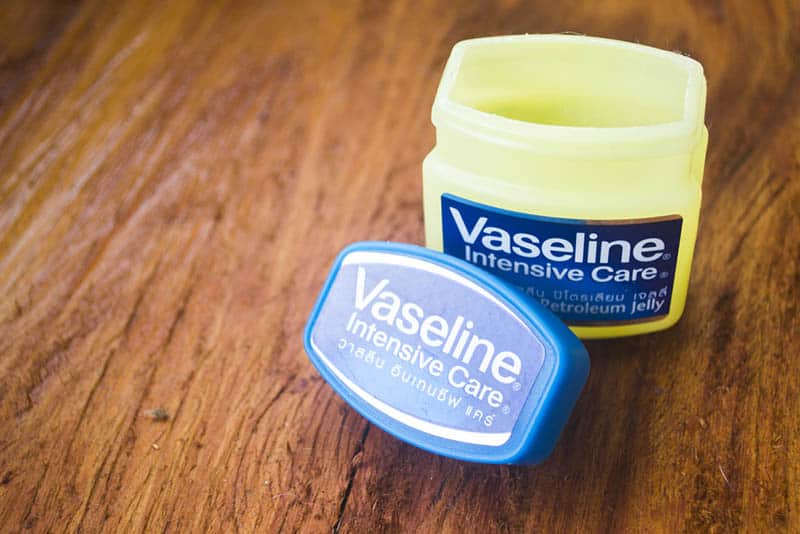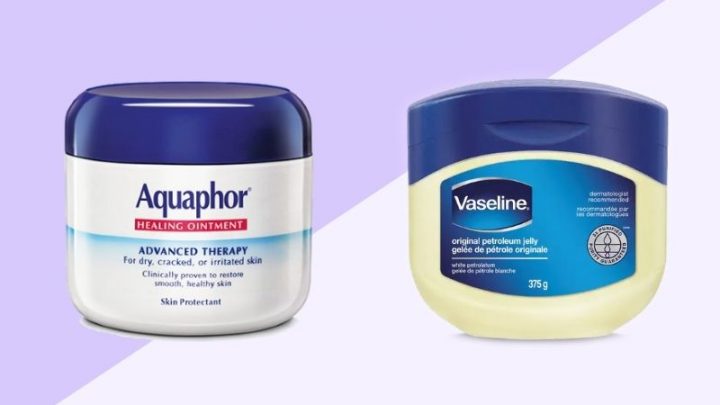When it comes to petroleum jelly there’s always a heated debate between Aquaphor VS Vaseline about which one is better. And that’s what I’m here for today!
After a few initial looks at the Aquaphor VS Vaseline competition, you might not really see a difference, they’re both brands of petroleum jelly after all. But, once you get into their ingredients, you’ll start realizing all the relevant qualities and differences.
Things like the ability to trap moisture in the skin by forming a protective membrane, helping with the moisturizing of the skin, or the benefits to wound healing are functions that both products share, but they also have their unique uses like actually helping draw moisture in from the air among other things.
They’re the two best-known brands in the business and that’s unlikely to change, at least for a while.
The goal here is to compare the two and see which one of them truly is the best petroleum jelly brand. Keep in mind that this is a personal opinion formed through the information I’ve found during my research. You’re still free to choose whichever brand you personally prefer.
RELATED: 21 Best Baby First Aid Kit Must-Haves
Aquaphor VS Vaseline: The Rundown
First things first, we need to inspect what each of the two products bring to the table and then compare them to see which is best for which occasion.
1. Aquaphor Healing Ointment – Moisturizing Skin Protectant
- One essential solution for many skin care needs: Use as a lip moisturizer, hand cream, foot cream for dry cracked feet, minor wound care and much more
- Different from a lotion or cream, this ointment nourishes skin while creating a protective barrier that allows for the flow of oxygen to create an ideal healing environment
- Extreme weather conditions and frequent exposure to water, hand soap, and hand sanitizer can cause dry cracked hands and cuticles.
Prices pulled from the Amazon Product Advertising API on:
Product prices and availability are accurate as of the date/time indicated and are subject to change. Any price and availability information displayed on [relevant Amazon Site(s), as applicable] at the time of purchase will apply to the purchase of this product.
The first of the two petroleum jelly products is Aquaphor, something that you might possibly have lying around the house for general use when you need to soothe a mild injury or a burn.
Aquaphor is also used as a skin and lip moisturizer to aid in maintaining proper skin care by repairing cracked skin as well as preventing dry or chapped lips.
The same goes for the area around the hands or feet if you’re someone who either walks a lot or does a lot of manual labor during the day.
A good application of this product is likely to soothe the pain as well as mend any cracked skin.
This skin care product works by locking the moisture in when applied after cleaning up the application spot.
It helps seal the area from any outside infection by forming a protective barrier around it, a membrane if you will which helps speed up the healing process.
It’s this specific healing property that makes it a must-have around every household, especially when dealing with smaller children who are prone to getting all sorts of minor cuts, infected cuticles, and dry skin patches.
An interesting fact is that Aquaphor isn’t entirely petrolatum which is the compound that makes up petroleum jelly, but rather a healthy mix – an improvement on the original with some new ingredients added in.
The petrolatum percentage is only about 41% (give or take a little) while the other components include:
• Ceresin which is a coal and shale rock-based mineral wax
• Panthenol, a B5 vitamin extract
• Bisabolol, a soothing agent taken directly from chamomile plants
• Mineral oil taken directly from petroleum
• Lanolin alcohol extracted directly from animal skin
• Glycerin, an ingredient which acts as a humectant
Now, this last ingredient is one of the more interesting ones as humectants help make Aquaphor into a moisturizer on top of being a cream which actually enhances its effectiveness. A proper 2-in-1 double-whammy deal and a really unique package in the Vaseline VS Aquaphor competition.
On top of that, the product is fully fragrance-free and is recommended for use by dermatologists worldwide in the topical treatment of skin dryness, minor wound care, and for soothing burns and the like.
That said, there is one thing that you should be on the lookout for and that’s the Lanolin ingredient.
While normally a beneficial one, there’s a chance that you or a family member may possess a lanolin allergy which can lead to a lot of redness, swelling of the face or lips, and potentially worse side effects.
Should you start suffering from any of these symptoms, call your doctor immediately and drop the use of Aquaphor.
2. Vaseline 100% Pure Petroleum Jelly
- Vaseline 100% Pure Petroleum Jelly, 13-Ounce Jars (368 Gm) (Pack of 6)
Prices pulled from the Amazon Product Advertising API on:
Product prices and availability are accurate as of the date/time indicated and are subject to change. Any price and availability information displayed on [relevant Amazon Site(s), as applicable] at the time of purchase will apply to the purchase of this product.
The other contender is an even better-known brand, Vaseline, one that you’re more likely to actually have a tub or two of in your house. This product is widely available from drug stores or online over on Amazon.
That’s because it’s made out of 100% petrolatum with no extra added ingredients meaning the likelihood of a potential irritant like lanolin is minimized, giving it a solid edge over the other product in the Aquaphor VS Vaseline showdown.
That said, there are extremely rare cases of people being allergic to petroleum jelly in general in which case you might want to avoid using either of them altogether.
And, the uses for Vaseline are just as broad as that of Aquaphor, if not better, serving to protect your child’s sensitive skin from conditions such as diaper rash, minor cuts, and burns.
While great as a form of skin lotion, it can also work as a lip balm to help heal dry and chapped lips.
Comparing The Two

Now that I’ve listed the benefits of each product, it’s time to see how they square up against one another in the various categories of the Aquaphor VS Vaseline showdown, and then I’ll declare a winner.
1. Occlusive moisturization: A tie
This one comes as no surprise.
The main purpose of petroleum jelly is to act as an occlusive moisturizer and skin protectant, to keep the moisture in and protect the skin from drying out and becoming cracked or damaged further, giving it a temporary reprieve and time to heal.
This happens thanks to the protective membrane that ends up forming once either product is applied to the affected area.
Not only that, but the two also possess the added benefit of functioning as makeup removers, albeit not as strong as the products intended for that very purpose.
2. Self-moisturization: Aquaphor wins
While both products work as occlusive moisturizers, aiding actual ones in helping keep the skin well hydrated, Aquaphor also works, on its own, as a form of moisturizer.
This is all thanks to its varied chemical compound, one of the main elements being glycerin, a humectant that I mentioned earlier which acts as an independent moisturizer without the need to rely on other products.
3. Dealing with chapped lips: A tie
Both products have an edge over one another when it comes to specific uses for dry and chapped lips: Aquaphor can remoisturize them after they’ve already become dry while Vaseline tends to be good as a prevention method by helping keep the existing moisture in.
They both also end up giving a really nice sheen to your lips after application which might be an aesthetic benefit that interests you over and above the medicinal values that they both have.
Do note though that if you’re looking for a similar product in the Vaseline branch that works specifically for lips, you might want to try their lip balms which are designed for that very purpose.
4. Soothing inflammation: Aquaphor wins
When it comes to dealing with burns or inflamed/irritated skin, you might want to turn to Aquaphor because some of its ingredients carry anti-inflammatory properties which help keep the skin protected while reducing pain and discomfort.
The reason why it’s better than Vaseline in this regard is because the latter might just end up stalling the healing process as it locks out air circulation around the affected area.
That said, the former should be used only as a temporary solution during the first day or two before switching to a soothing lotion specifically designed to treat stronger irritation.
5. Wound healing: Vaseline wins
When it comes to dealing with minor cuts and injuries, the ingredient purity of Vaseline slightly trumps the mixed bag of ingredients of Aquaphor.
The latter is more likely to cause irritation or redness on the skin area around the wound after the injury than the former which is why Vaseline edges out on top in this category.
6. Burn treatment: Vaseline wins
Because Vaseline helps keep air away from burns, the area doesn’t get irritated further and allows the skin’s innate moisture to heal and repair the affected tissue.
Meanwhile, Aquaphor might end up just worsening the issue further thanks to the mix of ingredients, namely lanolin in this case.
7. The price tag: Vaseline wins
And, as always, there’s the matter of price. Something can be a miracle cure but if it’s too expensive, it might not be worth it.
In this case, Vaseline can be anywhere from 2-4 times cheaper than Aquaphor while having similar benefits placing it on the winner’s podium in this category.
And The Winner Is…

For me personally, the winner is Vaseline by a solid margin, but to be honest, I do have a bit of personal bias there because my kid has a mild lanolin allergy.
Not only that, but the lower price tag makes it a more budget-friendly option compared to Aquaphor. Because the effectiveness and functionality are relatively the same, Vaseline is way better in my opinion.
That and the fact that I tend to use petroleum jelly when treating minor wounds and wanting to help in accelerating the healing process.
That said, if neither you nor any other member of your family has issues with lanolin, I’d say that you should give Aquaphor a go, mostly because of the fact that it’s also a moisturizer on top of everything else, meaning you have one less product to shop for.
It’s also slightly more effective at preventing water loss than its competitor, but that is to be expected with a higher price tag.
EXTRA: A Word Of Warning

While it may seem that both products can perform remarkably well in helping treat burns and other skin problems, there is one thing that neither of them should be used for and that’s in treating sunburn.
That’s because both of them help keep the moisture from the body in which also keeps the body’s heat in, a fact that doesn’t help your body deal with the problem at hand.
It’s much better to actually apply sunscreen to help prevent the problem from occurring in the first place rather than attempt using either of the two products as an aftersun.
Summing It All Up
When considering the Aquaphor VS Vaseline contest, it’s important to note that it all comes down to personal preference more or less.
The latter is a more budget-friendly product that helps deal with cuts and bruises better than the former while Aquaphor is better at dealing with skin inflammation, but boasts a higher price tag.
There’s also the potential risk of the user suffering from the effects of a swollen face or itchy skin if they have a lanolin allergy, though those cases aren’t that common.
Should it happen though, I advise you to swap to the alternative.
In any case, I hope that this has been an insightful look at the benefits and disadvantages of both of these top-tier products and that you can make a wise and more informed decision on which one to get.
If you have any further questions on the more detailed benefits of both products as well as any potential risks, I suggest contacting your dermatology specialist or any other certified skin care professional on the matter and have them suggest the right jelly accordingly.
Until next time, mammas.
Like this post? Please share or pin it for later. You can also stay in the loop and follow us on Facebook, Instagram or Pinterest.

We love honesty! Find Your Mom Tribe is an Amazon Associate and we earn from qualifying purchases through affiliate links at no extra cost to you. Please see our full Amazon Affiliate disclosure for more information.


